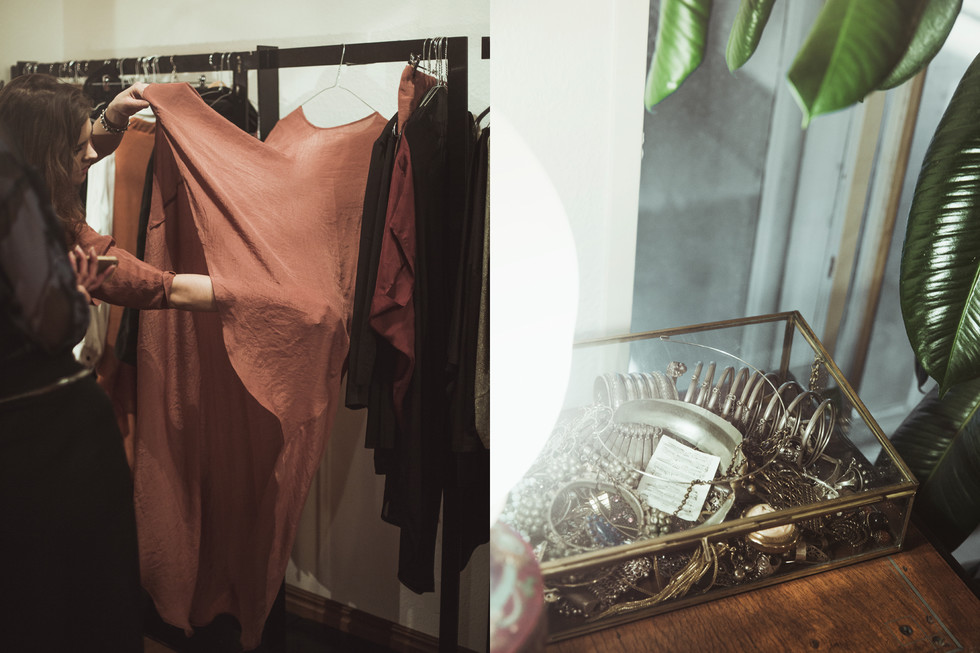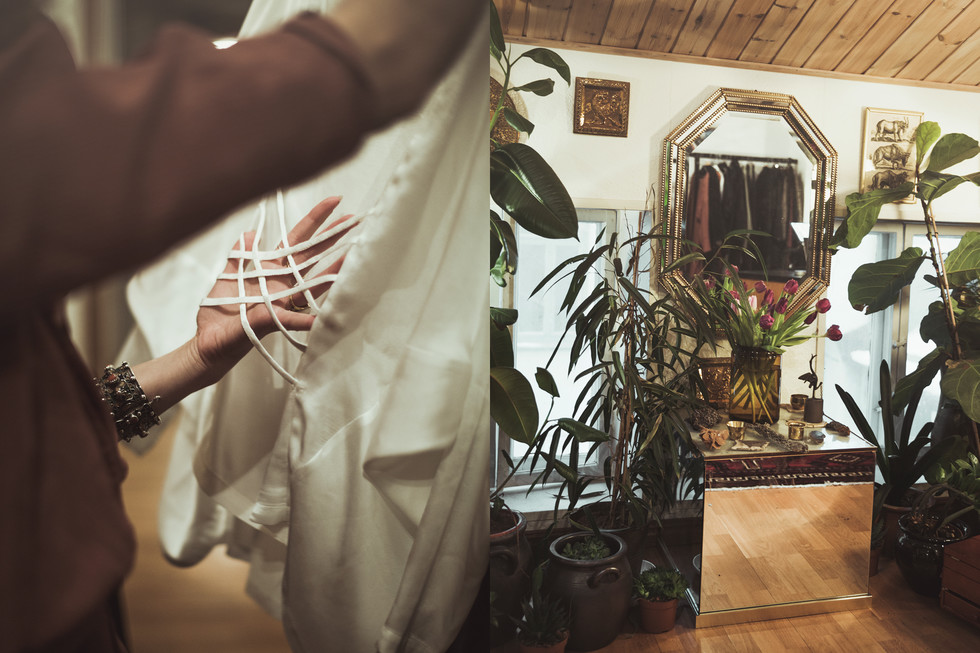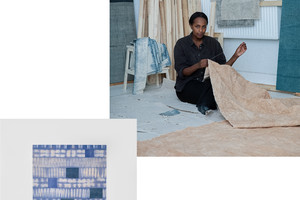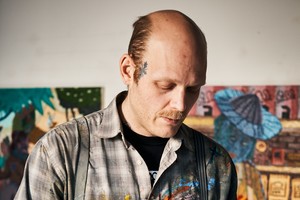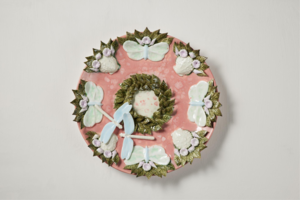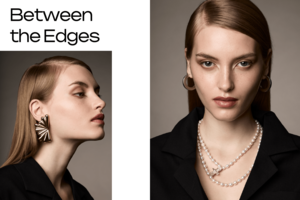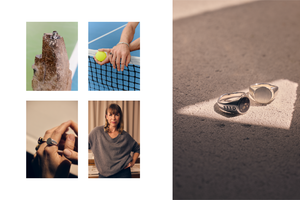An interview with Diana Orving
Written by Jade D'econzac Mbay by Michaela WidergrenMeeting Diana
Diana Orving is described as a wonder child artist, starting her career at the age of fifteen. She’s commonly known for her fashion label Diana Orving, but this Swedish designer is far more than that. She has done everything from textile installations to stage costumes for the Swedish royal Opera. It’s Thursday afternoon, the snow and wind makes everything seem raw and cold outside Diana’s studio, which is hidden in a backyard in the trendiest neighborhood in Stockholm: Södermalm, close to “Sofo”. We are moving around Diana’s studio to find the place that she finds most comfortable. She decides to go for the wooden desk and gently makes room for herself on the top of it, with her legs crossed.
JDM: It has been almost a year since we've seen each other! How has the start of the new year been for you?
DO: It’s been good! I have been involved in making costumes for the Epiphany concert in Berwaldhallen, I designed studio made pieces for three opera singers and for the Swedish TV hostess Petra Mede. After that I went to Rome. I needed to collect some new energy and some sun! Then it was time to make some progress on the new collection that I am going to show next week. But if I would return to your question about 2015, I would say that it has been a good start of the new year!
JDM: You began by designing and producing clothes when you were fifteen years old. What got you started?
DO: It probably has a lot to do with the environment I grew up in. My mom works as an artist. She worked a lot with textile art so I used to play around with her fabrics and borrow her sewing machine, which I still do! Ha ha- long term lending fifteen years later!
JDM: Did you ever doubt your own ability to create clothes, having had no formal practice in how to do it?
DO: When I started making clothes I did it mainly for myself. I didn't feel like I had any limits or that I needed to have a clear idea; instead I tried my way forward and played with the knowledge and fantasy I had back then. After high school I started to produce and sell my clothes to stores around town.
JDM: Were you insecure about how people would approach you when you were young and trying to find your way into the fashion industry?
DO: I had no clue how it all worked, knew nothing about seasons or agencies. I would just walk in with my clothes in a bag and ask if I could sell them there. I am glad that I didn't know any right or wrongs in those early days, the process of doing it my way has felt healthy.
JDM: What were your ambitions when you began with your carrier?
DO: I didn’t know what would become of what I created, I found more motivation in the fact that people were buying my clothes. It was fun and full of lust, later it became more of an economical motivation because I wanted to move away from home, ha ha! I needed to sew a lot to achieve that! It became my extra job at the time I attended high school and gradually I learned how to construct a garment and to find my own ways of doing it. After that I started to find it ever more interesting to discover different kind of silhouettes, shapes, cuttings and techniques within draping without any basic skills. I didn’t know the basics. After high school I had already passed the stage of just practicing design for my own interest, and art school didn’t seem like an option. Instead I moved to London to continue selling my clothes abroad, but also to collect inspiration. A lot of the inspiration came from the people I met, and a lot of those people I met at clubs. But then I decided to go back to Sweden, where I shared a studio with three other friends. There it all started to head in the direction of the making of my own brand. By the year 2007, I cut back on my production of handmade clothes and began producing more clothes in factories.
JDM: How much does your work get affected by who you are?
DO: I would say that almost everything gets affected by me in different ways. I work alone and therefore the line between my inner life and my work is very hazy. There is no one else that can control my choices, all the materials and fabrics are made from stuff that I have found. I am weaving myself into everything when I create my clothes. I create clothes that I would like to put on; it’s like an extension of my own wardrobe. What is the most private or personal is pretty universal, if I create a garment formed by my body type I am pretty sure it will be valid for many others. To sum it up it’s a lot of me and I can get really tired of myself sometimes, ha ha.
JDM: How would you then describe your process from step one to the finished product?
DO: The first part of the process is a never ending collection for inspiration and I can get inspired by everything, for example different pieces of art or a type of tonality. Depending on what period I find myself in I can feel attracted to different themes or objects. My whole life is kind of spilling into my work, if I travel somewhere it can be the temperature or the impressions of the surroundings that inspires me and leaks into the collection that I am working with at that time. But I would say that the gathering of inspirational material is what takes the most time. After that when all the pieces that from the beginning didn’t seem to work together, start to create a sort of pattern or a clear picture, I can continue working to the next step.
JDM: You say that you have a habit of getting “stuck” in the collecting of inspiration stage; does that lead you setting a deadline for yourself?
DO: I have a habit of staying in the collecting phase a bit too long and I have really tried to sort it out by using a day to day calendar. The first day goes well and I proudly mark it with “TODAY” and feel satisfied but then day two comes and so on and the calendar remains empty because I can’t plan like that. But I always seems to finish in one way or another, I get motivated by the last intensive weeks, it’s like breathing in all the impressions first and then letting them be a part of me. Then I blow it all out and start to create.
JDM: What stage of your process tends to hold you back from continuing working?
DO: It’s usually when I am starting to feel that I am done with the collecting stage and on my way to start producing. Before I start producing the garments it can sometimes feel like I have already done them because of how long I have been thinking about them. By that stage I can feel kind of empty and having a hard time to come up with something new, but I try to always remember that I feel the same empty feeling every season and let myself be comforted by remembering that I am a creative human being and that the feeling of emptiness will disappear sooner or later. The only thing I can do when I feel like that is to forget what everyone is expecting and not get stressed.
JDM: Are you left - or right handed?
DO: RIGHT!
JDM: What tools do you like to have in your right hand?
DO: I have this special pen in ink with a sharp tip, it doesn’t matter if I have three other pens laying around me, I can’t write without it. Then it’s my mom’s old Bernina sewing machine that she bought secondhand back in the 70s, I need it to sew all the toile. I feel uncomfortable sewing on other machines exactly like writing with other pens, those are my two favorite instruments.
JDM: How does it feel to see someone wearing your creations?
DO: It’s hard to forget the first time and I wish that I would feel the same strong euphoria today that I did back then but I still can get excited when I see someone wearing something that I have done, because the garment comes to life. In the beginning when I was selling to smaller stores I remember that the girls from the band “Sahara Hotnights” bought some shirts that I had done. I felt so cool. Then in the beginning it was a special feeling seeing someone wearing a garment that I had made and finished, that I had put down my time and used my inspiration to create. It felt like I had a relationship to the person and sometimes I could approach the person and be super happy and say “I MADE THAT”.
JDM: When did you feel that you had found your own expression? And do you think it’s hard to continue developing your expression and still keep it original?
DO: I had made a whole collection of clothes that I was going to show at Riche, everything was made under a certain period. I had chosen the models and some friends and I had built the scenography. When everything was done and I saw the models walking around in my garments and the surrounding that we had created I thought: “Wow, I actually made this!” It became clear for me after that show how I wanted to present myself as a designer, and the themes that was important for me to maintain; it felt complete in some way. Then it changes from different periods, because when I try out new techniques I can’t expect to feel the same feeling of happiness and confidence that everything is going to work out and fit with how I want it to feel. At the same time it’s important not to forget that it’s a goal or pursuit and that is what I am seeking all the time.
Originality and creating something original doesn't feel so important to me because I am pretty sure at what I am good at and I know what it is my regulars appreciate in my garments. My brand is not a brand trying to be trendy, you can recognize my garments independently of what collection it comes from, you recognize my voice, my language that is creating a certain thread in my work that gives it the keynote and that’s more important than the pursuit of the most spectacular looking piece.
JDM: How would you describe your vision of your success?
DO: Success, can be many different things and I could definitely have made different choices that could have benefited my career from a financial perspective. It could have been a bigger company with more hired staff and I could have had my own shops. But all this is barely possible to achieve when you have worked as long as I have done, and the most important thing for me in any case is to stay true to my own ideas and keeping my creativity alive. My motivation has been more about my artistic motive and has pushed me to keep on creating and made me start to make clothes rather than becoming just a fashion designer, “it-person” or having a big company, I am an artist. In the end I always have to think about business though, because it’s still a company that I manage, but I still keep on putting as much time I can into making way for my artistic project rather than focusing my energy on reaching out to a bigger crowd.
JDM: Besides working with your own brand you have worked a lot with stage costume. One was for the Swedish Royal opera, what made you want to work with stage costume?
DO: Being a designer and making your own collections can in many ways be kind of lonely and like I mentioned before, it’s easy to get tired of yourself. It’s exciting to come into another world where other artists are working with drama or choreography and to get involved in the way the dancers are moving, understanding the music and who the characters are and how I should interpret, boost or contribute a layer to the story that is being told. It’s fun to be one of the fingers on the hand making the final result without being the protagonist.
JDM: Apart from your own brand and stage costumes you have done some textile installations, you did one “correct me if I seem critical”, and that I personally got really surprised by. What is the biggest difference between creating a garment as compared to a whole installation?
DO: I got the proposal to do a textile installation for the collection, the gallery was in Berlin and also the name has nothing to do with my installation, it belonged to the whole collection at the museum. Working with textiles and relating to a room instead of a body gives me totally new ways of creating; there are other possibilities and limits. It takes a lot of time and it’s harder in many ways but it’s so exciting creating which such big volumes and not knowing if it’s going to work or not. It’s like creating in the dark. The excitement with what you can create with a room is a very abstract way of creating and it’s my way of sculpting things.
JDM: Sliding into something that’s happening very soon… Stockholm fashion week is coming up. What was your main inspiration in making this collection?
DO: I usually think very abstractly, there is rarely a “I am inspired by this” for me, it’s more about other impressions like shapes, silhouettes and how the fabric falls, if it’s going to be ties, twists or braids. These kinds of things dominate my inspiration. There was no specific inspiration, it was more like trying my way forward with taking photo of very abstract objects. I like to look at things that I don’t understand. I am going to show you some of the prints that are going to become a part of the collection.
Diana steps down from the desk and I slip down from the velvet divan to the floor in order to study the abstract prints more closely; it’s hard to explain what they are supposed to be. Or not be.
JDM: When I see these I immediately think about an X-ray of the brain.
DO: Exactly! Also space, inside the body, fire, fetus, water, air and all kind of different elements! Crust of the earth, it could be inside a volcano, it can be anything depending on the audience. I have also thought about witches that are boiling something in a gigantic pot. Witches as in strong women that have been full of their will, knowledge and independence. Witches in a positive sense. It’s still a loose idea but it connects to the thoughts of self-willed and integrity which I wanted to interpret into the garments.
JDM: Any dominating materials in the collection?
DO: Could be the green velvet fabric, I am not just thinking about the fabric or if it’s going to fall nice, but also that it has to feel good for the person wearing it. I have also used cupro, viscous and some fabric with more weight.
JDM: Are you nervous for how you will be received by the fashion audience this year?
DO: Let me think… In the last stage right before I am going to present what I have been working on during such a long time it’s not really about the reception from the audience that makes me nervous, but more if everything is going to work out as I want it to. It’s often on the day of the show that I can feel somewhere that I have already moved on. I try to have fun the last week and spend time in the studio and create during the nights. I can get nervous if I haven’t been able to enjoy the last week and haven’t had my “dream flow”. But I mean of course I get happy if the audience responds in a positive way.
JDM: You have been celebrated for your choice of not using “regular” models in your fashion shows, instead using your friend that inspirers you or “real” women, why did you choose to brake this model norm? And how will it look this year?
DO: I do what feels most natural for me and this year I have not decided yet which models will walk, but I will continue in the same track.




